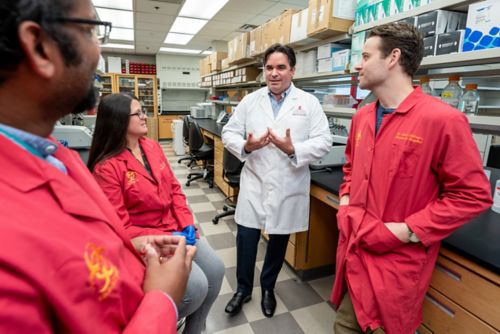St. Jude Family of Websites
Explore our cutting edge research, world-class patient care, career opportunities and more.
St. Jude Children's Research Hospital Home

- Fundraising
St. Jude Family of Websites
Explore our cutting edge research, world-class patient care, career opportunities and more.
St. Jude Children's Research Hospital Home

- Fundraising
It takes a village to tackle resistant pathogens

Understanding how hosts and pathogens interact gives researchers the knowledge needed to tackle antimicrobial resistant pathogens.
For children undergoing cancer treatment, the cells of their immune system often fall victim to the effects of their necessary life-saving therapy. This immunosuppression can occur due to off-target effects of chemotherapy and radiation or by design, as with bone marrow transplantation, where the patient’s own cancerous immune cells must be removed and replaced with healthy donor immune cells. Either way, the loss of immune cells leaves cancer patients highly vulnerable to the onslaught of viral, bacterial and fungal pathogens in our environment.
“In our patient population at St. Jude, where a lot of our patients are immunosuppressed, microbes become our biggest enemy,” said Victor Torres, PhD, Chair of the Department of Host-Microbe Interactions (HMI) at St. Jude Children’s Research Hospital. “We are deploying state-of-the-art therapeutics to combat cancer, but our ability to contain infections is diminishing every day. Antimicrobial resistance is a tremendous problem for our patient population.”
At St. Jude, Torres leads the HMI department with an ambitious vision to combat infectious diseases affecting children, as such diseases remain among the leading causes of death in children worldwide. But to understand how infectious diseases impact children and design better treatments, an appreciation for both the immune system and the pathogens causing disease is required. Studying the interaction between a host (a child’s immune system) and the microbe (the infectious disease–causing agent) gives a more accurate picture of the ways infectious diseases impact health.
Uncovering new strategies to battle an old foe: S. aureus
Torres has built his research program around the important human bacterial pathogen Staphylococcus aureus (S. aureus). He believes a multidisciplinary approach “is the key to unearthing new biology” and explains that his philosophy is “to make a difference one protein, one gene and one microbe at a time.” As such, Torres has used S. aureus “as a model to understand a large gamut of biology, from fundamental microbiology to epidemiology, to biochemistry, to genetics and immunology.”
Infections caused by S. aureus are estimated to kill approximately 20,000 people a year in the United States and cause over one billion dollars a year in health care costs. In global surveys, S. aureus ranks number two amongst antimicrobial-resistant bacterial-infection-related deaths.
Up to 30% of the population carries S. aureus on their skin or in their nose, where it lives as a harmless colonizer. However, if the protective skin barrier is breached, S. aureus can penetrate and infect every tissue and organ in the body, attacking and disarming the body’s immune system along the way. S. aureus possesses a large arsenal of virulence factors, including surface proteins and secreted toxins and enzymes that enable the microbe to thrive.
“Staph is like a Swiss Army Knife; it has so many different tools to achieve what the organism wants to accomplish,” explained Torres.

Victor Torres, PhD, with members of his laboratory at St. Jude.
Torres made a name for himself studying and characterizing the S. aureus leukotoxins, a group of virulence factors that predominantly target immune cells (also called leukocytes). These leukotoxins form pores in the immune cell membrane, ultimately killing the cell. Torres and his team were among the first researchers to determine that leukotoxins use specific proteins on the immune cell surface as receptors to dock to the cell. Since that discovery of the CCR5 protein as a receptor for the leukotoxin LukED, published in 2013 in Nature, Torres and his collaborators have identified eight other receptors for five different leukotoxins.
This work has uncovered that the toxins can target more than just immune cells and has also provided a possible explanation for the long-standing question of why S. aureus has so many toxins — each likely has a specific role to play during infection.
“We have been working with a naive framework. We realize now that the mechanism whereby S. aureus causes skin infection might differ from the mechanism by which the organism causes osteomyelitis (bone infection), necrotizing pneumonia or bloodstream infection,” said Torres.
Disarming the leukotoxins by blocking their interactions with their respective receptors has become a prominent focus of the Torres Lab. This strategy may be promising for the development of therapeutics and vaccines against S. aureus, which have remained elusive.
Torres has worked on multiple preclinical studies with toxin-based S. aureus vaccine candidates and biologics, published in the Journal of Infectious Diseases, the Journal of Experimental Medicine and Cell Host Microbe, and he plans to continue this work.
“Despite being studied for over 100 years, we still don’t have vaccines or biologics to block S. aureus, and it’s becoming ever more challenging to tackle this pathogen due to its resistance to antibiotics,” Torres stressed. “The hope is that, at St. Jude, we will accelerate some of the fundamental discoveries into potential preventives or treatments to contain this bug.”
Building a new model to study drug-resistant pathogens
S. aureus is part of a larger group of hospital-associated bacterial pathogens, aptly named ESKAPE pathogens, due to their ability to “escape” antimicrobial therapy. These six ESKAPE pathogens (Enterococcus faecium, S. aureus, Klebsiella pneumonia, Acinetobacter baumannii, Pseudomonas aeruginosa and Enterobacter species) are responsible for most of the hospital-acquired infections in the world.
In the last five years, Torres has expanded his research program from S. aureus to include the understudied second “E” in ESKAPE, Enterobacter cloacae complex. Torres quickly realized that working with current E. cloacae strains isolated from patients in the hospital setting would be key to uncovering the pathogen’s virulence mechanisms.
“If our goal is to prevent infections, then we must study contemporary microbes. Studying fundamental biology is essential, but we should do it with microbes and primary human cells that actually matter. It’s messy, it’s more complex, it’s more variable, but that is the biology of human infections,” said Torres.
Such an approach also emphasized that better animal models were needed to study ESKAPE pathogens, which typically don’t cause disease or even establish an infection in traditional mouse models. This prompted Torres to ask, “Can we make a mouse model reflect the biology of a hospitalized patient? If we can do that, we could unlock the virulence potential of these ESKAPE pathogens.”
By mirroring food and water intake observed in hospitalized patients, Torres’s team created a model, recently published in Science Advances, by which mice became hyper-susceptible to multiple ESKAPE pathogens. This model allowed the team to explore the mechanism by which the mice become susceptible, finding reduced functionality of immune cells responsible for engulfing and killing invading pathogens. Unlike other immunosuppression models that rely on artificially depleting or removing specific immune cells from the equation, Torres’s model’s impact on immune responses is temporary and likely more reflective of the typical hospitalized patient. Future work with this model will aim “to generate new therapies, vaccines and antibodies against microbes that previously could not be studied in a complex setting of an infection,” explained Torres.
Confronting antimicrobial-resistant infections through collaboration
It is becoming increasingly clear that antimicrobial-resistant infections do not exist in a vacuum and that bacterial and viral co-infections are and will continue to be a major problem in both healthy and vulnerable children.
“We are in an intellectually vibrant ecosystem here at St. Jude, where we not only have the best of the best scientists, equipment and resources, but we also tackle the most challenging questions. I believe tackling antimicrobial-resistant infections in silos would be a mistake,” explained Torres.
To break down silos in research, Torres is leading the creation of the Center of Infectious Diseases Research (CIDR), a cross-institutional center designed “to answer complex questions that a single lab or a single department cannot tackle,” explained Torres. “To make a difference in infection biology, we need to bring together the people who are interested and who have something new and different to offer. That means infectious diseases doctors, pharmaceutical scientists, pathologists, computational biologists, data scientists, structural biologists, cell biologists, chemical biologists, microbiologists and virologists, to name a few.”
“The hope is, as time progresses, we can show the value of multidisciplinary science, collaborative science and cross-fertilization in terms of new data and discoveries,” continued Torres. “Hopefully, then we’ll start translating those discoveries into clinical studies, clinical trials, new therapies and new preventives. The partnership of HMI and CIDR with the Department of Infectious Diseases is key.”
Scientifically, Torres’s work is about capturing the whole picture of how a pathogen and its host environment, including the host immune system, interact in disease. Through his leadership of HMI and collaborative efforts, such as CIDR, Torres is continually pushing toward obtaining that complete picture, leveraging different expertise and perspectives to better understand the pathogens that pose the greatest risk to St. Jude patients and children worldwide.






